
Osteochondrosis of the cervical spine is well known and studied. Currently, the vast majority of the working population suffers from this disease. This type of osteochondrosis develops not only in the adult population, but is quite common in adolescents, called juvenile osteochondrosis.
The cervical area is the easiest part of the spine to move, so the load in this area is quite large. The disease progresses gradually, it is characterized by a frequent increase, which can lead to a significant decrease in the quality of life of the patient.
Causes of disease
There are usually several causes of the disease and may depend on the age of the patient. Let's highlight the most frequently:
- violation of calcium-phosphorus metabolism of any etiology;
- various traumatic back injuries;
- unbalanced load on the spine (physical inactivity or, conversely, the effect of increased load);
- diseases of the cardiovascular system;
- congenital spinal deformity;
- posture changes, including scoliotic type;
- circulatory disorders that cause poor intervertebral disc nutrition;
- age-related bone tissue dystrophy disorders.
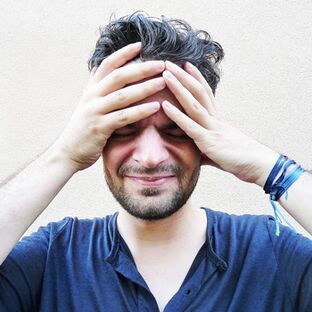
During adolescence, the main cause of the development of the disease is injury, unbalanced physical activity (exercise process). In elderly patients, the main reason is the long-term habitual position at work, hormonal imbalance.
Additional prognosis factors for the development of this disease are:
- descent;
- hypothermia;
- the severity of osteochondrosis;
- stressful situations and overwork.
Osteochondrosis develops gradually. A person who is constantly involved in sports may not realize that he is prone to the disease.
Most of these conditions occur in people over twenty-five years of age. Osteochondrosis of the cervical spine is characterized by the fact that the process develops from the upper extremities. However, if you do not get medical treatment, this process can gradually affect the lower part of the spinal space.
Symptoms of cervical spine osteochondrosis in adults and children
As the disease progresses over the years, in many cases the process is not symptomatic. Sometimes it happens that coincidentally from the X-ray picture it is possible to determine the early signs of the disease, while there will be no active complaints. It should be noted that the older the patient, the more complaints he or she will make.
The main complaints of cervical osteochondrosis are:
- frequent headaches and dizziness;
- numbness in the fingertips and weakness in the arms;
- vegetative manifestations;
- increased blood pressure;
- discomfort with movement in the neck;
- persistent pain or pain along the spine;
- frequent neck muscle myositis;
- posture changes;
- restrictions in head movement;
- forced head position can also expand;
- tinnitus;
- weather dependence;
- cramps in the neck while performing movements;
- sleep disorders.

These are the symptoms most often expressed by patients. Unfortunately, the process can begin to develop since adolescence, and adolescents will make similar complaints.
A large number of these symptoms occur simultaneously. Osteochondrosis of the cervical spine occurs with episodes of improvement and remission. This is due to the effect of provoking factors on the body. We must not forget that if a similar diagnosis is made, rehabilitation and rehabilitation therapy must be done every six months to avoid an acute period.
Given that the main cause of the development of this disease is a decrease in trophism of the intervertebral disc, and lack of adequate therapy, this process can end with the formation of an intervertebral hernia.
Complaints and clinical picture of the disease - photos
Vascular manifestations in the form of dizziness or headache worsen when performing basic motor tasks (tilting or turning the head). Overall from all complaints, patients strive to take a compulsive stance to reduce symptoms, which exacerbates the nutrition of the intervertebral disc.
This complaint is what most often prompts patients to see a doctor. If treatment is not carried out, complaints will increase and become more persistent, that is, they will not disappear on their own.
Pain in cervical osteochondrosis, as a rule, persistent, painful, and burning. The disease can be accompanied by periodic "lumbago", which is provoked by sudden movements.
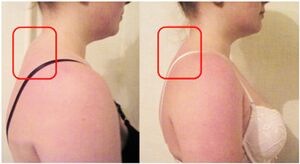
Increased blood pressure against the background of osteochondrosis encourages patients to be examined by a therapist. If proper treatment is not done in a timely manner, the increase in blood pressure will be constant, which contributes to the development of secondary hypertension. In this situation, a properly compiled anamnesis is very important.
When the process is localized in the cervical spine, discomfort spreads in the back of the neck, constant tension of the musculoskeletal system contributes to restriction of movement and the formation of forced head positions.
Pain in cervical osteochondrosis is accompanied by impaired sensitivity. Because of the persistent discomfort, muscle rollers gradually form in the shoulder area, palpation of the patient experiencing discomfort in this area.
In addition to persistent discomfort, patients may experience sharp shooting pain in the neck. Incidents like this show that patients must rest completely to reduce pain. In some cases, the pain is so severe that a person is unable to perform the simplest of actions (turning his body, taking a deep breath, straightening his back). In all cases, the patient should be examined by a physician and the diagnosis of osteochondrosis should be confirmed.
Changes in hormone levels also play an important role in the development of cervical spine disease. Therefore, the selected physical activity will reduce the general clinical symptoms and reduce the patient's condition. Due to the fact that neck pain is always annoying, secondary sleep disorders occur. It is difficult for a person to take a comfortable position in bed, anxiety, which causes psycho-emotional stress.
In addition, patients pay attention to sensitivity violations. They are described as "goosebumps" that are felt at your fingertips. In some cases, discomfort can be localized to the entire arm, and muscle strength decreases.
Disease Diagnostics
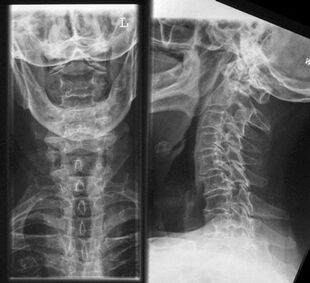
It is quite difficult to make a diagnosis based on an examination. Basically, to clarify the diagnosis, the following activities are performed:
- comprehensive collection of complaints;
- consultation of a specialist (cardiologist, endocrinologist, neurologist);
- X-ray examination of the cervical spine;
- magnetic resonance imaging.
Examination by a specialist doctor is required to exclude acute conditions of cardiological and other profiles. With the exception of acute somatic pathology, one can discuss the diagnosis of osteochondrosis. In addition to the general clinical manifestations, the diagnosis can be confirmed using X-ray examination of the spine.
X-rays are the most affordable and easy-to-use test to aid diagnosis. The image shows a narrowing of the space between the vertebrae, which indicates dystrophy of the intervertebral disc. Bone growth can be distinguished along the edges of the vertebrae. If osteochondrosis is complicated by instability in the cervical spine, then on x-rays a person can see the interconnected vertebrae.
Osteochondrosis of the cervical spine is a disease that can be shown radiographically which area is most damaged. Even while examining a cervical segment, you can see that the process is uneven.
In very difficult cases, magnetic resonance imaging is performed, which helps diagnose complications of osteochondrosis - intervertebral hernia. Thanks to layer-by-layer MRI images, it is possible to determine the smallest hernial changes and immediately show the extent of the lesion.
Treatment of cervical spine osteochondrosis
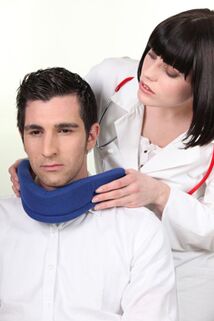
Only a doctor knows how to treat cervical osteochondrosis in the acute and interictal periods. The therapy prescribed for this condition should be comprehensive. With the onset of worsening disease, it includes:
- medicine
- ;
- complex rehabilitation therapies (physiotherapy training, gymnastics, massage, acupuncture, manual therapy);
- physiotherapy (electrophoresis, UHF, magnetotherapy, laser therapy);
To prevent worsening of osteochondrosis, run to:
- spa treatments;
- traditional medicine;
- wear special wraps and corsets;
- lifestyle changes (weight loss, balanced physical activity).
Remedies for the treatment of osteochondrosis of the cervical spine are as follows:
- anti-inflammatory drugs;
- drugs that increase blood circulation;
- vitamin complex;
- in acute, analgesic conditions;
- means reducing muscle tension.
In addition to pills and injections, creams, ointments and gels are actively given, which are applied to the affected area. As a result, they contribute to skin irritation in certain areas, which increases blood circulation in small ducts, thus ensuring the delivery of nutrients to damaged segments, and reducing muscle tension.

After the acute period, physical therapy, massage and physiotherapy training are scheduled. Rehabilitation therapy is in addition to mainstream medical treatment. As conditions improve, nutrition and trophism of the intervertebral disc will also improve.
During treatment, patients will see an improvement in well-being, increased efficiency and mood. If treatment is stopped, without resolving it, then the deterioration of osteochondrosis will often pass.
How to treat cervical osteochondrosis during the recovery period will be told by a rehabilitation therapist. Before discussing the complex of rehabilitation therapy, it should be noted that any treatment must be accompanied by bed rest. These include orthopedic mattresses and pillows.
Experts also recommend wearing Shants collars permanently or for a limited period of time. This method is widely used in children's training, when patients wear it during homework. Shants collars are individually selected in orthopedic salons.
Orthopedic pillows for cervical osteochondrosis are selected for each patient. It should fit the size of the bed and be selected depending on the patient's constitution. Should not be too small or very large, the main guideline is one’s shoulder width.
Pillows for long sleep and rest must be moderately tense and resemble a square or rectangular shape. Other forms are suitable for short breaks. Depending on the activity of the degenerative process, orthopedic pillows for cervical osteochondrosis should be changed.
Exercise and gymnastics (lfk)

Recovery therapy should include gymnastics. The main tasks of the exercise are to strengthen the neck and back muscles, the upper shoulder belt, increase spinal mobility, and eliminate muscle cramps. In addition, exercise for cervical osteochondrosis affects the muscles located inside.
As a result of gymnastics in cervical osteochondrosis, the physiological curve is gradually restored, and the load on the intervertebral disc is reduced. We must not forget that training for cervical osteochondrosis should also include the thoracic segment.
Gymnastics for cervical osteochondrosis is performed with instructors. This helps the patient understand which areas need more emphasis. The load and number of tasks are selected individually, and depend on:
- from patient age;
- about the norm of the process;
- from the presence of additional comorbidities;
- on the effectiveness of drug therapy.
At first, the task is simple and not difficult to do, as the body begins to adapt to new conditions, and the muscles do the work in sufficient amounts, the training becomes more difficult, and the duration of the session increases.
Exercise therapy for cervical osteochondrosis includes moderate action. This tilts the head back and forth, gradually increasing the movement of the round head. Keep in mind that even for physiotherapy training there may be contraindications. As a rule, the complex of a lesson includes tasks aimed at developing and influencing all segments of the spine.
After training in the cervical spine, tasks are gradually added to improve the work of the thoracic and lumbar spine. Physiotherapy exercises for cervical osteochondrosis can be done in a standing or sitting position. The task is done gradually, at a low rate, this will allow for additional breathing exercises.
Contraindications to physiotherapy training:
- acute pain syndrome;
- increased blood pressure and the presence of cardiac pathology in the acute phase;
- coordination disorders and diseases of the vestibular apparatus;
- temperature rise;
- exacerbation of other chronic pathologies;
- state after surgical treatment.
Special Technical Training
This technique is based on the restoration of the phase of normal activity of the musculoskeletal system. Gymnastic exercises, performed on a specialized simulator, allow you to gradually restore the structural structure of the cervical spine.
First, the pain is eliminated, then blood circulation is restored, muscle tension is removed and classes are performed to expand motor activity in the cervical spine. This method is also supported by massage courses, pool classes.
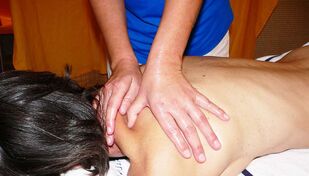
Massage for osteochondrosis of the cervical spine
In addition to general strengthening exercises, massage gives a very good effect. Massage for cervical osteochondrosis can be used in a variety of (classical, segmental, colon). In some cases, a combination of different techniques in one session is allowed.
We must not forget that massage for cervical osteochondrosis is performed on a hard surface, facing down, and its duration can vary from ten sessions or more. The frequency of course repetition is also determined by the attending physician. The effectiveness of the massage will last longer if the patient sleeps on the right pillow.
Physiotherapy procedures such as magnetism or electrophoresis have a local irritating effect. Magnetotherapy is a painless procedure that is acceptable to both adults and children. Manipulation lasts for a few minutes, the patient must lie still, therefore most often recommended for older patients.
Electrophoresis is a manipulation performed using special tools. During the procedure, the patient feels a slight tingling sensation caused by current. Frequency and impulsive signals vary for each age. This technique is used to inject drugs that have a positive effect. This manipulation is more aggressive compared to magnetotherapy, so there must be strict guidelines for its implementation.
This technique is used to inject drugs that have a positive effect. This manipulation is more aggressive compared to magnetotherapy, so there must be strict guidelines for its implementation.
A balanced diet is essential for this disease. Patients are advised to eat fruits, vegetables, meat, herbs, fish. You should limit your intake of salt and all kinds of spices, seasonings, smoked or fried foods, sugar. It is better to drink decoctions and herbal teas, it is recommended to avoid drinking coffee and alcohol.
Traditional medicine is used to reduce pain. Often, compresses and mixtures are used, which are applied to the affected area. Success in the treatment of osteochondrosis of the cervical spine is highly dependent on the patient's awareness. You should not quit classes and start therapy as soon as you feel better. It is irrational to always use painkillers that bring temporary relief, and the disease itself does not heal.




























